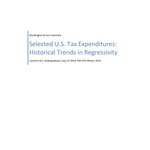Selected U.S. Tax Expenditures: Historical Trends in Regressivity

View/
Author
Gill, Caroline H.
Subject
Washington and Lee University, Shepherd Poverty Program
Tax expenditures
Progressive taxation
Earned income tax credit
Child tax credits
Tax deductions
Metadata
Show full item recordDescription
Caroline H. Gill is a member of the Class of 2014 of Washington and Lee University. Capstone; [FULL-TEXT RESTRICTED TO WASHINGTON AND LEE UNIVERSITY LOGIN] U.S. tax expenditures represent $1.2 trillion dollars of lost federal tax revenues in 2013 due to exclusions, deductions, deferrals, and credits allowed by the tax code. Without tax expenditures, the US government would collect enough additional tax revenue to budget for nondefense discretionary spending twice over again. This paper asks how necessary tax expenditures are as they are written in the tax code today, what is the regressive impact of these tax expenditures, have they become more or less regressive over time, and can these tax expenditures be made more progressive while still preserving their original intent? First, this paper reviews the size, structure, value, and composition of tax expenditures as a whole. Then, this paper explains the design, purpose, legislative history, growth, and progressivity/regressivity of six selected tax expenditures (earned income tax credit, child tax credit, exclusion for pension earnings and contributions, mortgage interest deduction, exclusion for employer-provided health insurance, and the preferential rates on capital gains). After commenting on overall historical trends of regressivity, the paper discusses and recommends policies that increase the progressivity of tax expenditures while preserving their original policy intent. Caroline Gill